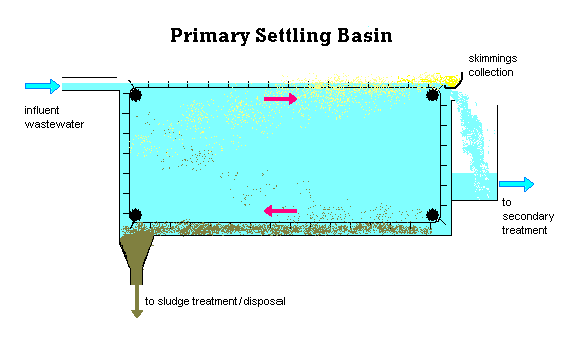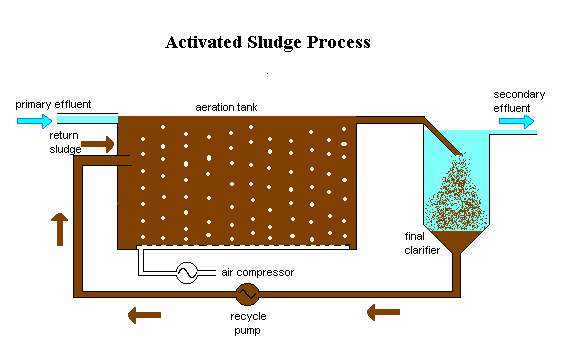Wastewater treatment

Wastewater is more commonly known as sewage. Wastewater treatment is a vital part of making sure that we live in a pleasant and healthy environment. Wastewater typically contains pathogens, and usually organic matter which allows the pathogens to multiply, and absorbs oxygen from the water. It also contains nutrients, which in the right context are good, but in a natural water body can be very damaging, in a process known as eutrophication.
Wastewater treatment and technology[edit | edit source]
We want fishable and swimable water. another application is to prevent merciless use of ground water whenever possible to make our reserve sustainable. Appropriate technologies for wastewater treatment may be capable of reducing the health and environmental impact of wastewater. This may include any of the following:
- Lowering the amount of water that people use, which would lower the amount of waste,
- Treating the wastewater anaerobically with a Biogas digester, which would extract energy from the waste and reduce the volume
- Treating the sewage in a non-electric filter sewage treatment plant system, or
- Nutrient removal, for nitrogen and phosphorus.
Comments:
- With our advanced living standards, per capita water requirement is bound to rise. we need to know intelligent reuse of the same.
- Anaerobic treatment needs high investment and energy generated is less.
- Nutrient removal is highly recomended.
How wastewater is treated[edit | edit source]
Wastewater is treated in Wastewater Treatment plants. There are two major types of wastewater treatment plants, biological plants, and physical/chemical.
Biological plants are mainly used to treat combined domestic and industrial wastewater from municipalities. The biological plants use micro-organisms to treat the waste water - almost the same process that occurs naturally. However at the biological treatment plants, the wastewater is being treated under controlled conditions. This is to ensure that the water is fully cleansed before it is placed back into the environment.
Most of the time, Physical/Chemical plants are used to treat industrial wastewater. This is because they normally contain chemical pollutants that could kill the micro-organisms in biological treatment plants. The physical plant process, usually treats suspended pollutants, rather than dissolved pollutants through the process of adsorption typically with activated carbon.
Wastewater treatment plants[edit | edit source]
A typical Wastewater Treatment Plant has a sequence of individual unit processes. The unit process has an output or effluent and an input or influent. With the unit process, the effluent of one becomes the influent of another.
The first stages is a physical processes that takes out the easily removable pollutants. The pollutants left over are then treated with a more advanced biological or chemical process. The biological and chemical processes will then do one of the following: 1) convert dissolved or colloidal impurities into a solid or gaseous form, so that they can be easily removed physically, 2) convert them into dissolved materials which remain in the water, but are not considered as bad as the pollutants that started out in the beginning. The solids, more commonly known as sludge or residuals, formed from the previous process also have to be treated, in order to be disposed of.
A typical Municipal Treatment Plant will have a three step process.
Intake: pumps and screening[edit | edit source]
The sewage flow will typically flow to the treatment works under gravity. This means that the sewage pipes will drop by approximately 1 metre in every ??? meter of travel. Ths slope must be sufficient to ensure the flow rate is fast enough to ensure the solids do not settle out in the pipe, causing blackages. By the time the pipe reaches the treatment plant it will usually be a long way down and will have to be pumped to the surface useing specialist sewage pumps designed to cope with the solids in the sewage inflow without clogging.
Preliminary treatment removes the larger solids, which could clog or damage the equipment. The equipment generally is along the lines of the following, grinders (comminuters), bar screens, or grit channels. The grinders chop up things like rags and trash. While the bar screens catches the larger objects, the ones that can be raked off of the screen. The grit channels help the heavier materials to settle out, this is to prevent heavy wear on the equipment used farther down in the process. The grit channels also help to remove the larger food particles that remain.
Settlement tank[edit | edit source]
The next part is the Primary settling basins. This is where the water flows slowly for several hours, so that the solid matter can settle out. The primary settling basins are either circular or rectangular. Either type of settling basin has to have some type of scraper at the bottom, so that it can collect the settled sludge and direct it to a pit from which it can be pumped to get more treatment. The basin also needs skimmers at the surface, to collect the material that floats to the top.
Secondary treatment[edit | edit source]
The next part of this process is called Secondary treatment. The secondary treatment is usually a biological process, which tries to remove the remaining dissolved or colloidal organic matter. The process is the biodegradation, which takes place in a location where plenty of air can be supplied to the microorganisms. This promotes formation of the less offensive, oxidized products. The design and capacity of this treatment unit is established so that enough of the impurities will be removed to prevent significant oxygen demand in the receiving water after discharge. There are two major types of biological treatment. These two types are: attached growth and suspended growth.
Attached growth or trickle filter[edit | edit source]
During the attached growth process, microorganisms grow on a surface. The influent from the settlement tank is sprinkled over a suitable rocky substrate. Oxygen is required to establish an aerobic bacterial population. Newer designs often use electrically driven machinery for this. Older designs and those designed to be independent of electricity use gravity feed and natural air currents. Over time a layer of aerobic bacteria grows on the substrate. As the water flows over this the micro-organisms eat the contaminants in the waste water, converting them to water, carbon dioxide and other oxides.
Suspended growth or activated sludge[edit | edit source]
The suspended growth process is also known as activated sludge system. This system has two parts, an aeration tank and a settling tank. The aeration tank has a "sludge", which is best described as a mixed microbial culture. This contains mostly bacteria, as well as protozoa, fungi, algae, etc. This sludge is constantly mixed and aerated either by compressed air bubblers located along the bottom, or by mechanical aerators on the surface. The wastewater to be treated enters the tank and mixes with the culture, which uses the organic compounds for growth-- producing more microorganisms--and for respiration, which results mostly in the formation of carbon dioxide and water.
After the sludge has had the proper amount of aeration time, it is carried into the settling tank.The sludge collected at the bottom is then recycled to the aeration tank to consume more organic material. The term activated sludge is used, because by the time the sludge is returned to the aeration tank, the microorganisms have been in an environment depleted of food for some time, and are in a hungry, or activated condition, eager to start biodegrading some more wastes. Since the amount of microorganisms, or biomass, increases as a result of this process, some must be removed on a regular basis for further treatment and disposal, adding to the solids produced in primary treatment.
Energy use[edit | edit source]
Wastewater treatment currently consumes about 15 GW or about 3% of the electrical power produced in the United States. Domestic, industrial and animal wastewater together however contains about 17 GW of potential energy. At present, this energy is still untapped, yet could be extracted using a microbial electrolysis cells (MEC).[1]
See also[edit | edit source]
References[edit | edit source]
- ↑ Conversion of Wastes into Bioelectricity and Chemical by Using Microbial Electrochemical Technologies by Bruce E.Logan, Korneel Rabaey
- Ohio State University's fact sheet on wastewater treatment. [1]
- The Siemens, a water treatment facility, page. [2]
- The U.S. Geological Services page. [3]
- Sewage Treatment Plants and Systems Explained
- Sewage Treatment
- Sewage Treatment Process and Systems Explained
- Extended Aeration Explained
- Activated Sludge Process Explained

